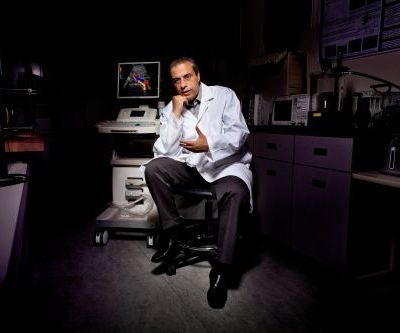Medical physics professor Jahan Tavakkoli and St. Michael’s researchers are exploring a new method to study concussion and its treatment.
In recent years, many Canadians have become aware of traumatic brain injury (TBI) through the reporting of concussions suffered by hockey players and other athletes. In addition to widespread sports-related injuries, TBIs often occurs as the result of, among other events, automobile collisions, workplace accidents and explosions (military and civilian).
The result of an impact or jolt to the head, or of an injury that penetrates the skull, a TBI disrupts normal brain function. It can result in relatively mild symptoms, such as headaches, memory lapses and mood swings, and more severe effects, such as loss of the ability to speak, see or move certain limbs.
A major public health issue
Ryerson University medical physics professor Jahan Tavakkoli has spent the last few years using acoustic shock waves to expand understanding of the mechanisms involved in and the physiology of TBI, and to lay the groundwork for potential treatments.
"TBI is a major cause of morbidity and mortality in industrialized countries. It is associated," Tavakkoli notes, "with considerable direct and indirect healthcare costs, as well as quality-of-life reductions." Figures from the Centers for Disease Control and Prevention back up these contentions: in 2010, more than 2.5 million TBIs occurred in the United States, and TBIs contribute to approximately 30 per cent of all injury deaths in that country.
Zebrafish model
Tavakkoli – a world expert in high-intensity focused ultrasound (HIFU) and acoustic shock waves – is carrying out his TBI investigations in collaboration with Andrew Baker, the medical director of the Trauma and Neurosurgery program at St. Michael's Hospital (the men first met in 2012 during a networking event hosted by Ryerson and St. Michael's).
Together, they are developing a zebrafish model of TBI using the hospital's state-of-the-art zebrafish screening facility. Zebrafish, Baker explains, "are an emerging model organism for studies of disease and human brain development because of their high evolutionary homology to humans, rapid procreation rate, suitability for whole-animal in vivo imaging and genomic amenability to large-scale preclinical drug validation."
Tavakkoli and Baker also rely on several highly qualified personnel to assist with their endeavours: on the Ryerson side, Pooya Sobhe Bidari (PhD student) and Arthur Worthington (research engineer); at St. Michael's, Victoria McCutcheon (MSc student) and Eugene Park (research associate).
Methods and results
By applying targeted 1-MHz acoustic shock waves to adult zebrafish brain, Tavakkoli, Baker and their colleagues have been able to produce non-penetrating brain injuries and have learned that zebrafish respond to brain trauma in ways that are similar to mammals. This work has allowed the creation of a novel animal model and methodology to induce controlled brain injury. "We are now able to study concussion in a way that has never been done before," Baker explains. "Because we have characterized this model in detail, we can measure in detail the reaction to concussion; therefore, we can also see in detail the response to new treatments. The potential implications for helping people suffering from TBI and its adverse effects are huge."
In November 2014, Tavakkoli and Baker filed an invention disclosure (to the intellectual property offices at both Ryerson and St. Michael's) based on the novel aspects of the materials and methodology they have thus far developed.
Provided by Ryerson University




















